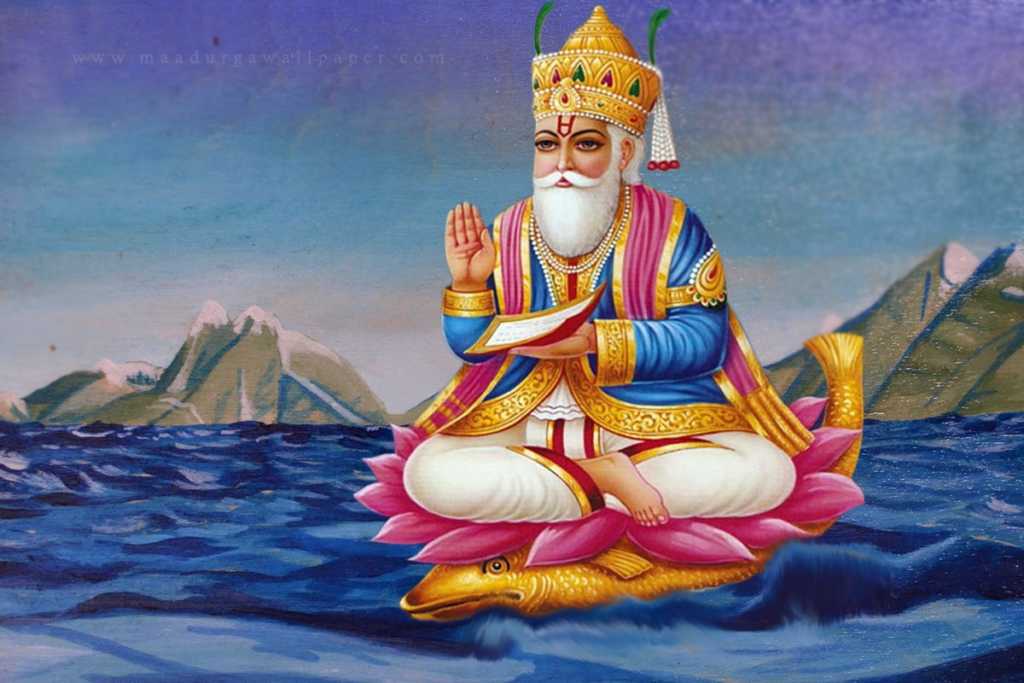“Jeko chawundo Jhulelal Tehnija Theenda Bera Paar”
(Whoever says Jhulelal, his ship will reach the shore safely)
From ancient times, Sindhis have been a sea-faring people. River Indus that flows through Sindh gave its people nourishment, resources, livelihood and security. As the Lord of the seas, Varuna-Deva occupies a special position among Sindhi Hindu families. And perhaps that is how it was for millennia when woe befell the native Sindhis. Armies of Islam arrived and occupied Sindh, wreaking havoc and shedding blood. One such story is commonly recounted in Sindhi households. It goes like this. In Thatta, Sindh, the Muslim ruler, Mirkshah was a tyrant. He was egged on by his Mullahs to force the Hindus to submit to Islam as that alone would guarantee him Jannat. Mirkshah asked the Hindu panches to convert or die. Hindus begged and beseeched Mirkshah who agreed to give them 40 days to plead with their God. The Hindus of Thatta solemnly prayed to Varuna-deva, asking him to come to their rescue. On the fortieth day, a voice from heaven asked Hindus not to worry. Soon thereafter, Varuna-Deva took birth in the household of Ratanchand of Nasarpur. The boy was named Udaychand or Uderolal as also Amarlal. The Hindus, now confident that their Lord had arrived to save them, ignored Mirkshah’s deadlines to convert. Hearing of Uderolal, Mirkshah devised plans to eliminate the boy, all of which failed. After foiling Mirkshah’s plans, Uderolal displayed his powers and forced Mirkshah to accept the folly of his ways. Uderolal, or Jhulelal is commonly depicted as a man with a beard, seated on a lotus placed on a Palla fish, native to Indus. Sindh’s unique geographical position as a melting pot of cultures meant that the story also became an exemplar of religious tolerance underlining a common cultural tradition. When Sufism took hold in Sindh, it appropriated many cultural and Social icons from Hinduism. Jhulelal the avatar of Varuna-Deva was re-defined as Sufi saint Shahbaz Qalandar, an incarnation of Khwaja Khizr. Irrespective of the religion, Jhulelal is worshipped by Sindhis all over the world and is a common heritage of Sindhis, a symbol perhaps of a time gone by.
One only wonders what dirty tricks is Scroll upto by publishing a highly erroneous and misleading article on Jhulelal.
Ignoring centuries of tradition, the article claims that Jhulelal or Uderolal was a Hindu boy in Sindh in 18th century who converted and became Shaikh Tahir. A shrine in his name exists in Uderolal, Sindh, where a lamp burns day in and out. The article adds that Uderolal was an upright man and it was because of him that Sindhi Hindus did not practise the caste system. As if that weren’t enough, Scroll adds that Hindu Sindhis re-discovered Jhulelal in the aftermath of partition because they couldn’t identify with the Hinduism prevalent in India.
The whole Scroll article is so farcical and nonsensical that one can’t begin to point out its flaws. It is infinitely more obvious that Sufis adopted the legend of Jhulelal and modified it to meet Islamic sensibilties. If it were the other way round, why would the Hindus only appropriate Shaikh Tahir and not other Sufi spiritual leaders and as if that weren’t enough, elevate him to an exalted status? Similarly, while Indus occupies a distinguished position in the Hindu religious world, Islam is dispassionate about rivers and mountains, except perhaps the ones in Arabia. Hence, the connection between Jhulelal and Indus. It is strange that Muslims suddenly began to respect Hindu’s sensibilities and brought Shaikh Tahir to reside on the Indus, Lotus and Palla fishes, when no such concept exists in Islam. Once again, it seems certain that instead of a Muslim Shaikh being worshipped abruptly by Hindus, the Muslims (many of whom were converts) appropriated what was already a Hindu cultural icon and redefined it to suit their tastes.
Coming to the aspect of Hindus in Sindh not believing in castes because of Shaikh Tahir, Suffice it to say that Hindus of Sindh have been a minority in that region for centuries. Perhaps, they realized that their lives depended on unity and therefore shed some of Hinduism’s social tabboos. Another point to note is that Sindh, unlike many parts of India, was more cosmopolitan in nature, interacting with different civilizations, which perhaps loosened some of Hinduism’s social strictures. Also, Hinduism in Sindh was amenable to influences from Islam and later Sikhism, which are evident even today. Suffice it to say that the cultural millieu that Sindhi Hindus operated in did not encourage social mores that were prevalent in other parts of the country. It is questionable that Shaikh Tahir had anything to do with it.
Lastly, Sindhi Hindus did not emigrate to India because India enticed and lured them with promises. They were forced to flee to India to save themselves against the communal situation that developed in Sindh after the entry of Muhajirs from India and the anti-Hindu stand taken by the then Government of Sindh. It is nothing short of a tragedy, that Hindu Sindhis, at the vanguard of India’s independence were duped by Congress leaders and converted into stateless refugees, when Sindh in its entirety went to Pakistan, even though Hindus made up 25% of its population. Even today, the abduction and forced conversion and marriage of Hindu girls is a common occurence in Sindh. Lord Jhulelal, far from providing comfort in an alien land, reminds Sindhi Hindus that they have left their Lord and their holy land behind in Pakistan. Scroll can try to spin the story to suit its narrative but the truth remains that Lord Jhulelal was appropriated by the Sufis in their quest to make Islam more amenable to India. Worship him by any name Jhulelal or Khwaja Khizr or Zinda Pir or Shahbaz Qalandar but don’t besmirch his name to suit your petty ideological preferences.
